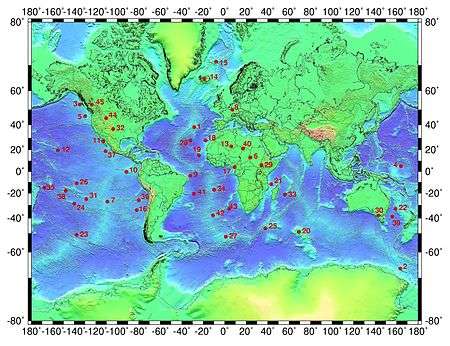Macdonald hotspot

The Macdonald hotspot is the Pacific Ocean, marked 24 on this map.
The Macdonald hotspot is a volcanic hotspot in the southern Pacific Ocean. The hotspot was responsible for the formation of the Macdonald Seamount, and possibly the Austral-Cook Islands chain.[1] It experienced a second eruption in 1989 (ibid).
Macdonald seamount has a shallow summit below sea level, at approximately 20m deep. It is named after Gordon A. MacDonald.[2][3] It erupted explosively in 1987, during which a specimen of floating lava composed of alkali basalt was sampled by researchers on the R/V Melville and subsequently analyzed.[4] It experienced a second eruption in 1989.[4]
References
- ↑ W. J. Morgan (1971). "Convection Plumes in the Lower Mantle". Nature. 230 (5288): 42. Bibcode:1971Natur.230...42M. doi:10.1038/230042a0.
- ↑ W. Jason Morgan and Jason Phipps Morgan. Plate velocities in hotspot reference frame: electronic supplement (PDF). p. 111. Retrieved 2010-04-23.
- ↑ John P. Lockwood (May 1980). "Gordon A. MacDonald, 1911–1978". Journal of Volcanology and Geothermal Research. 7 (3–4): 177–188. doi:10.1016/0377-0273(80)90028-1.
- 1 2 K.H. Rubin and J.D. Macdougall (1989). "Submarine magma degassing and explosive magmatism at Macdonald (Tamarii) seamount". Nature. 341 (6237): 50–52. doi:10.1038/341050a0.
This article is issued from Wikipedia - version of the 1/5/2016. The text is available under the Creative Commons Attribution/Share Alike but additional terms may apply for the media files.